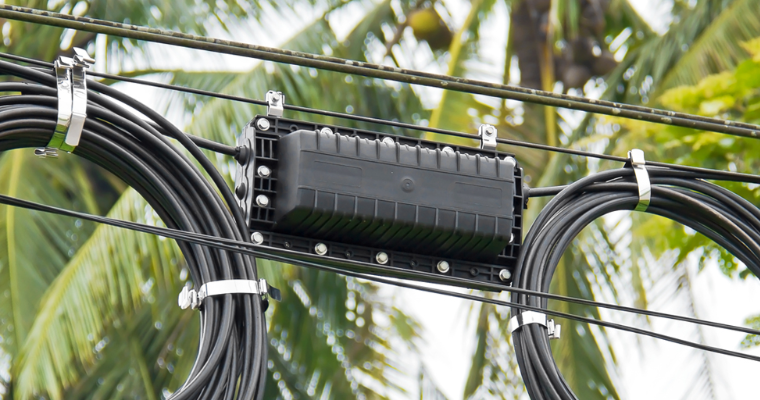Fiber optic splice closures play a crucial role in ensuring the durability and reliability of FTTH networks by protecting spliced connections. These closures, including the weatherproof fiber optic closure, are designed to maintain high-speed data transmission over long distances. Proper deployment of these systems, particularly with IP68 fiber optic closure options, helps to reduce operational costs. Additionally, both underground fiber optic closure and outdoor fiber optic closure systems enhance scalability, effectively supporting the growing demand for FTTH technologies.
Key Takeaways
- Fiber optic splice closures keep connections safe from weather damage. They help ensure smooth data flow in FTTH networks.
- Picking the right splice closure lowers repair costs and delays. This saves a lot of money over time.
- These closures help networks grow easily as more people need faster internet.
Understanding Fiber Optic Splice Closures
What Are Fiber Optic Splice Closures?
Fiber optic splice closures are protective enclosures designed to safeguard spliced fiber optic cables. These closures ensure the integrity of connections by shielding them from environmental factors such as moisture, dust, and temperature fluctuations. They are essential components in fiber-to-the-home (FTTH) networks, where uninterrupted data transmission is critical.
The industry classifies fiber optic splice closures into three main types based on their design and application:
| Type | Description | Key Features |
|---|---|---|
| Horizontal Design | Commonly used, versatile design for aerial or underground mounting. | Waterproof, dustproof, good compression resistance, various capacities (e.g., 12, 24 splice trays). |
| Vertical Design | Domed shape, primarily for buried applications but can be used above ground. | Seals for waterproofing, various configurations, designed for easier re-entry in some cases. |
| Hybrid Fiber Enclosure | Versatile for various installations, including wall and aerial. | IP68 rating, adaptable for different cable types, can be pressurized, compact design for various uses. |
The Role of Splice Closures in FTTH Networks
Fiber optic splice closures play a pivotal role in maintaining the reliability and performance of FTTH networks. They create an air-tight environment that protects spliced connections from environmental threats, ensuring long-term functionality. This protection prevents signal loss, which could otherwise disrupt data transmission.
Key benefits of splice closures include:
- Durability: High-quality materials provide exceptional mechanical performance and resistance to aging.
- Weather Resistance: They shield internal components from rain, snow, and UV radiation, ensuring consistent performance.
- Physical Protection: Dome-shaped closures minimize damage from external forces, preserving the integrity of spliced fibers.
Their functionality extends across various deployment scenarios:
- Protects splices from environmental factors like water, dust, and temperature changes.
- Ensures consistent signal quality and prevents signal loss or damage.
- Supports both underground and aerial installations, enhancing network stability.
By safeguarding fiber optic connections, these closures contribute significantly to the efficiency and scalability of FTTH networks.
Strategic Benefits of Using Fiber Optic Splice Closures
Enhancing Network Reliability
Fiber optic splice closures significantly improve the reliability of FTTH networks by protecting spliced connections from environmental and mechanical stress. These closures ensure that fiber optic cables maintain low signal loss and high performance, even in harsh conditions. Designed to withstand moisture, dust, and temperature fluctuations, they enhance the longevity of fiber optic networks.
- AFL’s Apex splice closures, for instance, can accommodate up to 1,728 splices in a 20-inch dome and 3,456 splices in a 25-inch dome.
- The wedge-based gel sealing system used in these closures simplifies installation, reducing the likelihood of errors and ensuring consistent network performance.
- By organizing and safeguarding spliced fibers, these closures prevent disruptions and maintain uninterrupted data transmission.
Reducing Maintenance Costs
Strategic deployment of fiber optic splice closures minimizes maintenance expenses by reducing the frequency of repairs and replacements. High-quality closures protect cables from damage, ensuring long-term reliability and cost efficiency.
| Benefit | Description |
|---|---|
| Reduced Downtime | Network downtime costs approximately $5,600 per minute, highlighting the need for reliable infrastructure. |
| Cost Savings | Ruggedized closures lower the risk of fiber damage, reducing replacement costs. |
| Installation Efficiency | Easier handling and bendability of cables lead to faster installations, cutting labor expenses. |
| Long-term Reliability | Durable closures ensure a lifespan of 25 years or more, minimizing future costs. |
Supporting Scalability and Future Expansion
Fiber optic splice closures play a crucial role in enabling network scalability and supporting future growth. Their versatile designs accommodate various configurations, making them ideal for expanding FTTH networks. As global demand for high-speed internet grows, these closures provide the flexibility needed to adapt to evolving requirements.
| Region | CAGR (%) | Key Drivers |
|---|---|---|
| Asia Pacific | 6.9 | Growing demand from telecommunications and IT industries. |
| South America | 5.5 | Innovation in splice enclosure designs for flexibility and scalability. |
| Middle East and Africa | 3.3 | Increased demand for secure communication networks and data centers. |
| North America | 4.5 | Advancements in technology and widespread fiber optic network deployment. |
| Europe | 4.8 | Rollout of 5G technology requiring high-capacity fiber optic networks. |

By integrating fiber optic splice closures into FTTH networks, operators can ensure reliability, reduce operational costs, and prepare for future expansion.
Comparing Types of Fiber Optic Splice Closures
Heat-Shrinkable Splice Closures: Pros, Cons, and Use Cases
Heat-shrinkable splice closures offer a reliable solution for protecting spliced fiber optic cables. These closures use heat-shrink tubing to seal and secure connections, providing excellent environmental protection. Their robust design makes them ideal for outdoor and underground installations where exposure to moisture and temperature fluctuations is common.
Advantages:
- Exceptional sealing capabilities prevent water ingress.
- Durable materials ensure long-term reliability.
- Suitable for harsh environments, including underground and aerial applications.
Limitations:
- Installation requires specialized tools and heating equipment.
- Re-entry for maintenance can be challenging.
These closures are commonly used in scenarios requiring high durability, such as rural FTTH networks or areas prone to extreme weather conditions.
Mechanical Splice Closures: Pros, Cons, and Use Cases
Mechanical splice closures simplify the installation process by eliminating the need for fusion splicing. They rely on mechanical connectors to align and secure fibers, making them a cost-effective option for smaller-scale deployments.
| Advantages | Limitations |
|---|---|
| Quick and easy installation | Lower reliability compared to fusion splicing |
| Compact design for limited spaces | Higher signal losses |
| Reusable and re-enterable | Gel coupling may degrade in outdoor conditions |
These closures are ideal for temporary installations or areas where rapid deployment is necessary. However, they are less suitable for high-performance networks due to their higher signal loss.
Tip: Mechanical splice closures work best in controlled environments where reliability is less critical.
Dome, Inline Horizontal, and Inline Clamshell Closures: Features and Applications
Dome, inline horizontal, and inline clamshell closures cater to diverse network requirements. Dome closures feature a rounded design, making them suitable for outdoor applications. Their efficient space utilization and easy maintenance access enhance their appeal. Inline horizontal closures, on the other hand, are compact and ideal for urban environments where space is limited. Inline clamshell closures combine flexibility with robust protection, supporting both aerial and underground installations.
Applications:
- Aerial: Protects against UV exposure and temperature changes.
- Underground: Shields cables from water ingress and physical impacts.
These closures provide versatile solutions for FTTH networks, ensuring durability and adaptability across various deployment scenarios.
Best Practices for Selecting and Deploying Splice Closures
Assessing Environmental Conditions
Environmental factors play a critical role in the performance and longevity of fiber optic splice closures. Conditions such as temperature, humidity, and exposure to moisture or dust can significantly impact the reliability of these closures. For instance, closures designed with robust sealing mechanisms effectively prevent environmental hazards like water ingress, ensuring optimal signal performance. Proper sealing safeguards the network from contaminants that could lead to signal loss or degradation.
When selecting a splice closure, operators should consider its environmental specifications. For example, closures with an installation temperature range of -5 °C to +45 °C and storage capabilities from -30 °C to +60 °C perform well in diverse climates. Additionally, closures that can withstand up to 93% relative humidity without condensation are ideal for high-moisture environments.
Aligning with Network Architecture
The choice of fiber optic splice closures should align with the network’s architecture to ensure seamless integration and scalability. Different network designs, such as centralized or cascaded architectures, require specific closure configurations. For example:
| Architecture Type | Description |
|---|---|
| Centralized using Closures | Feeder cable connects to a closure at the distribution point, allowing for future splitter additions. |
| Cascaded using Closure | Feeder fiber enters closure, passing through splitters to smaller closures closer to customers. |
| Cascaded with Fiber Reuse | Efficient use of fibers, with a single cable serving both feeder and distribution roles. |
By aligning closures with the network design, operators can optimize performance and simplify future expansions.
Balancing Cost and Performance
Cost and performance are critical considerations when selecting fiber optic splice closures. High-quality closures constructed from durable materials may have a higher upfront cost but offer long-term savings by reducing maintenance and replacement needs. For instance, closures with tool-less entry features simplify installation and maintenance, minimizing labor costs.
Operators should evaluate the trade-offs between initial investment and operational efficiency. Closures that balance affordability with robust performance ensure reliable network operation without exceeding budget constraints.
Why Choose Dowell for Fiber Optic Solutions?
Dowell offers a comprehensive range of fiber optic splice closures designed to meet diverse network requirements. These closures are built for reliability, withstanding extreme conditions to protect fiber optic cables effectively. Their user-friendly features, such as tool-less entry and adaptable designs, simplify installation and maintenance.
| Feature | Description |
|---|---|
| Reliability | Designed to withstand extreme conditions, ensuring long-term protection for fiber optic cables. |
| Durability | Constructed from high-quality materials for long-lasting performance. |
| Ease of Installation | User-friendly features like tool-less entry simplify access for maintenance and repairs. |
| Adaptability | Suitable for various applications including aerial, underground, and direct burial installations. |
Customers have praised Dowell’s solutions for their durability and ease of use. One customer noted that the installation process was smooth and hassle-free, while another highlighted the improved internet experience enabled by Dowell’s reliable connectivity solutions.
Fiber optic splice closures are essential for optimizing FTTH networks. Their strategic use enhances reliability, reduces costs, and supports scalability. Industries like telecommunications and IT have reported improved performance due to these closures, which minimize signal loss and ensure seamless data delivery.
Emerging trends further highlight their importance:
| Trend/Advancement | Description |
|---|---|
| Smart Monitoring Integration | IoT-enabled diagnostics improve fault detection and service quality. |
| Sustainability Initiatives | Recyclable materials promote eco-friendly solutions. |
These closures also reduce downtime by 40%, enabling proactive maintenance and ensuring long-term network efficiency.
FAQ
What factors should be considered when choosing a fiber optic splice closure?
Operators should evaluate environmental conditions, network architecture, and cost-performance balance. Selecting closures with robust sealing and durability ensures optimal performance in diverse deployment scenarios.
How do fiber optic splice closures support network scalability?
Closures accommodate various configurations, enabling seamless integration of additional connections. Their adaptability ensures that FTTH networks can expand efficiently to meet growing demands.
Are fiber optic splice closures suitable for extreme weather conditions?
Yes, high-quality closures with IP68 ratings protect against moisture, dust, and temperature fluctuations. These features ensure reliable performance in harsh environments, including underground and outdoor installations.
Tip: Always verify the closure’s specifications to match the deployment environment for maximum efficiency.
Post time: Apr-08-2025



